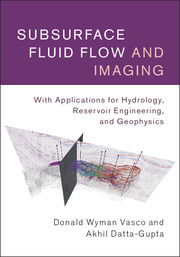 Subsurface Fluid Flow and Imaging
Subsurface Fluid Flow and Imaging Published online by Cambridge University Press: 05 July 2016
Background and motivation
In the study of the Earth one encounters a wide array of physical processes. Examples which quickly come to mind are transient pressure variations associated with fluid flow, the propagation of elastic and electromagnetic waves, inelastic deformation, reactive chemical transport, and multiphase flow. This diversity rivals that of any other discipline. On the surface, these phenomena may seem unrelated, and it is difficult to envision techniques, other than numerical modeling, which could prove useful across such a wide range of processes.
Our understanding of the complex systems that comprise our planet is hampered by a difficulty characteristic of the Earth Sciences; our observations are, for the most part, remote and indirect. That is, measurements are typically gathered at the Earth's surface or from a relatively small number of boreholes penetrating the depths. Thus, the details of the physical system are shielded from view by the Earth itself. To be sure, great advances have been made in geophysical imaging and in a sense it is possible to ‘see’ within the Earth. However, as compared to a physics laboratory, a completely controlled field experiment is the exception rather than the rule in the geosciences. This necessitates tackling what is known as the inverse problem, the complement to the modeling of a natural system. In the inverse problem, remote observations are used to infer properties, usually model parameters, describing the system. For example, seismic amplitude and arrival time changes gathered in time-lapse monitoring are used to infer saturation and pressure changes in a reservoir due to fluid production. Increasingly, other fields such as medicine and non-destructive testing are adopting imaging and inversion for non-invasive evaluation.
In large measure this book is concerned with modeling techniques developed with the inverse problems in mind. To this end we shall be concerned with methods that place a premium on efficiency, flexibility, simplicity, and physical intuition. For example, finite-difference techniques, extremely versatile but computationally intensive methods that often do not scale well with problem size, will not play a large part in our discussion. Rather, we shall emphasize trajectory-based techniques perhaps best known for their use in medical and geophysical tomographic imaging.
To save this book to your Kindle, first ensure [email protected] is added to your Approved Personal Document E-mail List under your Personal Document Settings on the Manage Your Content and Devices page of your Amazon account. Then enter the ‘name’ part of your Kindle email address below. Find out more about saving to your Kindle.
Note you can select to save to either the @free.kindle.com or @kindle.com variations. ‘@free.kindle.com’ emails are free but can only be saved to your device when it is connected to wi-fi. ‘@kindle.com’ emails can be delivered even when you are not connected to wi-fi, but note that service fees apply.
Find out more about the Kindle Personal Document Service.
To save content items to your account, please confirm that you agree to abide by our usage policies. If this is the first time you use this feature, you will be asked to authorise Cambridge Core to connect with your account. Find out more about saving content to Dropbox.
To save content items to your account, please confirm that you agree to abide by our usage policies. If this is the first time you use this feature, you will be asked to authorise Cambridge Core to connect with your account. Find out more about saving content to Google Drive.